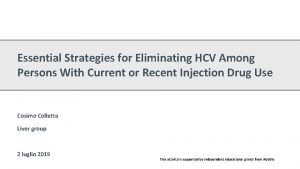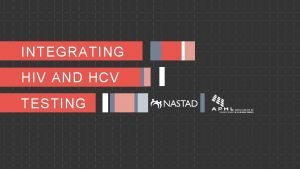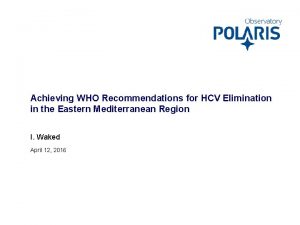Achieving WHO Recommendations for HCV in the European


















- Slides: 18

Achieving WHO Recommendations for HCV in the European Union A. Hatzakis Athens University Medical School April 13, 2016

The 28 EU countries account for nearly 70% of the total European population Countries in the European Union (population ~510 million) Austria Estonia Italy Portugal Belgium Finland Latvia Romania Bulgaria* France Lithuania Slovakia Croatia Germany Luxembourg Slovenia Cyprus* Greece Malta Spain Czech Republic Hungary Netherlands Sweden Denmark Poland United Kingdom Ireland • HCV disease burden models have been validated for 26 countries in the EU (98% of the EU population represented). • The model for Bulgaria has not been validated by local experts. • No assessment of Cyprus was conducted for this analysis. 2

In 2016, there approximately 3. 6 million viremic HCV infections in the EU (0. 7% prevalence) Prevalence (Viremic) 0. 0%-0. 6%-0. 8%-1. 3%-2. 9%-12. 0% Total Infected 100, 000 500, 000 1, 000 Source: Polaris Observatory (http: //www. polarisobservatory. com/) 3

In 2016, there are 3. 6 M viremic infections, 1. 2 M already diagnosed, ~1 M treated and 500 K cured in the European Union 33% Median Age: 54 • The viremic prevalence of HCV in EU is 0. 7% with one third of infections already diagnosed. • In 2016, an estimated 133, 000 patients (or 3. 7% of total infected) are treated. Source: Polaris Observatory (http: //www. polarisobservatory. com/) 4

There is a wide range of prevalence, diagnosis rates, and treatment rates across the European Union Bubble Diameter: HCV Prevalence Source: Polaris Observatory (http: //www. polarisobservatory. com/) 2% 1% 0. 5% 5

10 countries accounted for 85% of viremic HCV infections and 6 countries accounted for 80% of treated patients Viremic HCV Infections (2015) 85% of Total 80% of Total Number Treated & Treatment Rate (Treatment Rate) Source: Polaris Observatory (http: //www. polarisobservatory. com/) 6

The number of treated patients increased in 2014 and 2015 after a period of warehousing patients Total Number Treated in EU Source: Polaris Observatory (http: //www. polarisobservatory. com/) 7

Base 2014 Scenario – For comparison, the treatment paradigm in 2014 was extrapolated into the future • Continue to treat with Peg IFN based therapies • No treatment restrictions (treat anyone ≥F 0) • Screening is continued each year to find new HCV cases 2014 2015 2016 2017 2020 2025 77, 630 77, 630 Newly Diagnosed 96, 800 96, 800 Fibrosis Stage ≥F 0 ≥F 0 New Infections 59, 500 64, 900 62, 900 61, 100 59, 600 59, 400 Treated Age 15 -65 15 -65 SVR 57% 57% 57% Treated Source: Polaris Observatory (http: //www. polarisobservatory. com/) 8

HCV infections will decline by 40%, while liver related deaths (LRD), HCC & decompensated cirrhosis (DC) will increase by 30, 15 & 25% 9

Current 2015 Scenario – Extrapolate future treatment paradigm based on the current (2015) practice • Switch to direct acting antivirals with higher SVR • Keep the number of treated constant • Treatment is limited to those ≥F 2 until 2025 • Expand screening to find ≥F 2 2014 2015 2016 2017 2020 2025 77, 630 133, 300 133, 300 Newly Diagnosed 96, 800 101, 600 111, 800 167, 700 243, 120 Fibrosis Stage ≥F 0 ≥F 2 ≥F 1 New Infections 59, 500 64, 900 62, 900 61, 100 59, 600 47, 600 Treated Age 15 -65 15 -65 SVR 57% 75% 85% 90% 90% Treated 10

HCV infections will decline by 70%, while HCV related morbidity and mortality will decrease by 45 -55% 11

Elimination Scenario – Increase screening, treatment and eligibility to achieve a 90% reduction in new infections (excluding immigration) • Switch to direct acting antivirals with higher SVR • Increase treatment to achieve a >60% reduction in liver related deaths, 90% reduction in total & new infections • Expand screening to find infected individuals to treat • Expand treatment to all patients (>=F 0) • Starting in 2017, expand treatment up to age 70 2014 2015 2016 2017 2020 2025 77, 630 133, 300 159, 900 191, 900 230, 300 Newly Diagnosed 96, 800 101, 600 132, 100 171, 700 188, 900 207, 800 Fibrosis Stage ≥F 0 ≥F 2 ≥F 0 New Infections 59, 500 64, 900 62, 900 49, 200 33, 300 13, 300 Treated Age 15 -65 15 -70 SVR 57% 75% 85% 90% 90% Treated After 2030, less than 20, 000 individuals need to be treated annually 12

HCV infections will decline 90% by 2030 and 95% by 2035, while LRD will decline 55% by 2030 and 70% by 2035 Start to run out of patients to treat 13

HBs. Ag: In 2016, there an estimated 5 million HBs. Ag+ individuals in the European Union (data for 97% of the infected population) HBs. Ag+ (Prevalence) <1. 0%-2. 5%-5. 0%-10. 0% >10% Total Infected . 50, 000 250, 000 1, 000 The HBs. Ag+ prevalence in 2016 is estimated to be 1% Source: Polaris Observatory (www. polarisobservatory. com) 14

Eight countries accounted for 80% of all hepatitis B infections in the European Union HBs. Ag+ Individuals (2016) 80% of Total 96% % of infants receiving 3 doses of HBV vaccine (2014) 94% 0% 87% 96% 82% 95% Source: Polaris Observatory (www. polarisobservatory. com) 15

HBe. Ag+: In 2016, it is estimated that 15. 5% of HBs. Ag+ individuals in the European Union are HBe. Ag+ Prevalence (% of HBs. Ag+) <2. 5%-5. 0%-10. 0%-20. 0% >20% Source: Polaris Observatory (www. polarisobservatory. com) 16

HDV: In 2016, it is estimated that 9. 0% of HBs. Ag+ individuals in the EU are anti-HDV+, corresponding to 450, 000 HDV infections Anti-HDV+ Prevalence (% of HBs. Ag+) <2. 5%-5. 0%-10. 0%-20. 0% >20% Source: Polaris Observatory (www. polarisobservatory. com) 17

Conclusions: • There an estimated 3. 6 million HCV and 5. 0 million HBV infections in the European Union • Eight countries in the European Union account for 80% of HBV infections • Birth dose vaccination of infants remain non-existing or very low among Western European countries • It is feasible to eliminate HCV infection in the European Union » Treatment has to be increased to 6 -10% of total infections (coupled with active screening) » To reduce new infections, screening and treatment has to encompass all HCV infected individuals (≥F 0) – most new infections occur among younger individuals who are F 0 or F 1 » To reduce liver related deaths, eligibility has to increase to older patients – median age in EU is 54, and in 11 years half of the HCV infected population will be ineligible for treatment (if those above 65 are ineligible for treatment) 18
 Otto hoffman's by product oven
Otto hoffman's by product oven Douglas t dietrich
Douglas t dietrich Hcv treatment
Hcv treatment Hiv test window period
Hiv test window period Hcv treatment
Hcv treatment Hep c symptoms female
Hep c symptoms female Redogör för vad psykologi är
Redogör för vad psykologi är Lek med geometriska former
Lek med geometriska former En lathund för arbete med kontinuitetshantering
En lathund för arbete med kontinuitetshantering Mat för unga idrottare
Mat för unga idrottare Ledarskapsteorier
Ledarskapsteorier Publik sektor
Publik sektor Datorkunskap för nybörjare
Datorkunskap för nybörjare Fredsgudinna pax
Fredsgudinna pax Orubbliga rättigheter
Orubbliga rättigheter Rita perspektiv
Rita perspektiv Ministerstyre för och nackdelar
Ministerstyre för och nackdelar Nationell inriktning för artificiell intelligens
Nationell inriktning för artificiell intelligens Claes martinsson
Claes martinsson



































